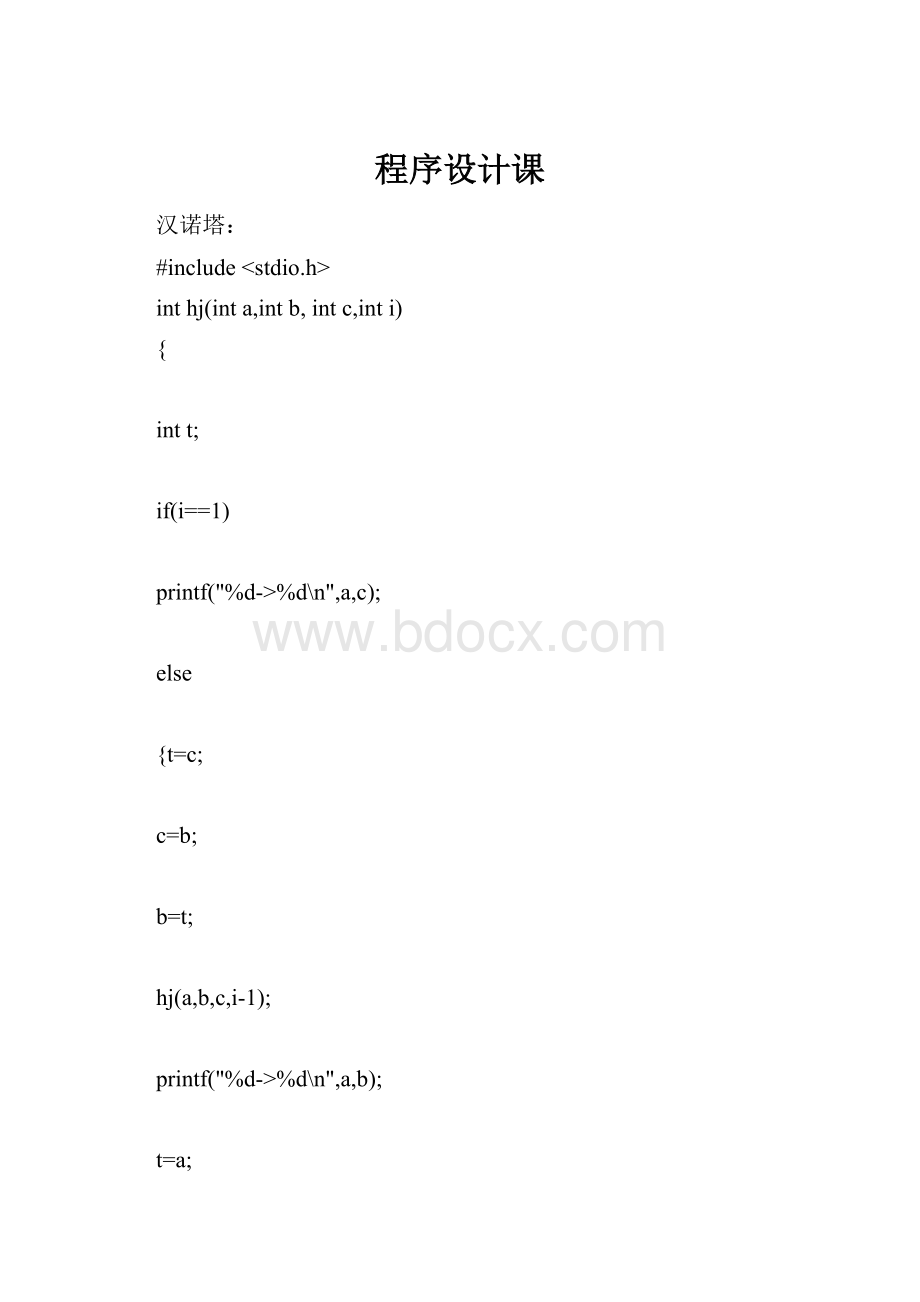程序设计课.docx
《程序设计课.docx》由会员分享,可在线阅读,更多相关《程序设计课.docx(44页珍藏版)》请在冰豆网上搜索。

程序设计课
汉诺塔:
#include
inthj(inta,intb,intc,inti)
{
intt;
if(i==1)
printf("%d->%d\n",a,c);
else
{t=c;
c=b;
b=t;
hj(a,b,c,i-1);
printf("%d->%d\n",a,b);
t=a;
a=c;
c=t;
t=b;
b=c;
c=t;
hj(a,b,c,i-1);
return0;
}
}
main()
{
inta,b,c,i;
a=1;
b=2;
c=3;
printf("
请输入汉诺塔的盘数
");
scanf("%d",&i);
hj(a,b,c,i);
return0;
}
快速排序:
#include
#include
#defineN6
intpartition(intarr[],intlow,inthigh){
intkey;
key=arr[low];
while(lowwhile(low=key)
high--;
if(lowarr[low++]=arr[high];
while(lowlow++;
if(lowarr[high--]=arr[low];
}
arr[low]=key;
returnlow;
}
voidquick_sort(intarr[],intstart,intend){
intpos;
if(startpos=partition(arr,start,end);
quick_sort(arr,start,pos-1);
quick_sort(arr,pos+1,end);
}
return;
}
intmain(void){
inti;
intarr[N]={32,12,7,78,23,45};
printf("排序前\n");
for(i=0;iprintf("%d\t",arr[i]);
quick_sort(arr,0,N-1);
printf("\n排序后\n");
for(i=0;iprintf("%d\t",arr[i]);
printf("\n");
system("pause");
return0;
}
最长公共子序列:
#include
#include
#defineN20
voidLCSLength(intm,intn,charx[N+1],chary[N+1],charb[N+1][N+1]);
voidLCS(inti,intj,charx[N+1],charb[N+1][N+1]);
voidmain()
{
intlx,ly;
charX[N+1],Y[N+1];
charB[N+1][N+1];
printf("请输入X序列:
\n");
scanf("%s",X+1);
printf("请输入Y序列:
\n");
scanf("%s",Y+1);
lx=strlen(X+1);
printf("X序列的长度:
");
printf("%d\n",lx);
ly=strlen(Y+1);
printf("Y序列的长度:
");
printf("%d\n",ly);
LCSLength(lx,ly,X,Y,B);
LCS(lx,ly,X,B);
}
voidLCSLength(intm,intn,charx[],chary[],charb[N+1][N+1])
{
inti,j,s,t;
intc[N+1][N+1];
for(i=0;i<=m;i++)
c[i][0]=0;
for(i=0;i<=n;i++)
c[0][i]=0;
for(i=1;i<=m;i++)
for(j=1;j<=n;j++)
{
if(x[i]==y[j])
{
c[i][j]=c[i-1][j-1]+1;
b[i][j]='A';
}
elseif(c[i-1][j]>=c[i][j-1])
{
c[i][j]=c[i-1][j];
b[i][j]='U';
}
else
{
c[i][j]=c[i][j-1];
b[i][j]='L';
}
}
for(s=0;s<=m;s++)
{
for(t=0;t<=n;t++)
printf("%d",c[s][t]);
printf("\n");
}
printf("length=%d\n",c[m][n]);
}
voidLCS(inti,intj,charx[],charb[N+1][N+1])
{
if(i==0||j==0)
return;
if(b[i][j]=='A')
{
LCS(i-1,j-1,x,b);
printf("%c",x[i]);
}
elseif(b[i][j]=='U')
LCS(i-1,j,x,b);
else
LCS(i,j-1,x,b);
}
哈夫曼编码:
#include
#include
#include
#include
#defineM100
typedefstructFano_Node
{
charch;
floatweight;
}FanoNode[M];
typedefstructnode
{
intstart;
intend;
structnode*next;
}LinkQueueNode;
typedefstruct
{
LinkQueueNode*front;
LinkQueueNode*rear;
}LinkQueue;
//建立队列
voidEnterQueue(LinkQueue*q,ints,inte)
{
LinkQueueNode*NewNode;
//生成新节点
NewNode=(LinkQueueNode*)malloc(sizeof(LinkQueueNode));
if(NewNode!
=NULL)
{
NewNode->start=s;
NewNode->end=e;
NewNode->next=NULL;
q->rear->next=NewNode;
q->rear=NewNode;
}
else
{
printf("Error!
");
exit(-1);
}
}
//按权分组
voidDivide(FanoNodef,ints,int*m,inte)
{
inti;
floatsum,sum1;
sum=0;
for(i=s;i<=e;i++)
sum+=f[i].weight;//
*m=s;
sum1=0;
for(i=s;i{
sum1+=f[i].weight;
*m=fabs(sum-2*sum1)>fabs(sum-2*sum1-2*f[i+1].weight)?
(i+1):
*m;
if(*m==i)break;
}
}
voidmain()
{
inti,j,n,max,m,h[M];
intsta,end;
floatw;
charc,fc[M][M];
FanoNodeFN;
LinkQueueNode*p;
LinkQueue*Q;
//初始化队Q
Q=(LinkQueue*)malloc(sizeof(LinkQueue));
Q->front=(LinkQueueNode*)malloc(sizeof(LinkQueueNode));
Q->rear=Q->front;
Q->front->next=NULL;
printf("\t***FanoCoding***\n");
printf("Pleaseinputthenumberofnode:
");
//输入信息
scanf("%d",&n);
//超过定义M,退出
if(n>=M)
{
printf(">=%d",M);
exit(-1);
}
i=1;//从第二个元素开始录入
while(i<=n)
{
printf("%dweightandnode:
",i);
scanf("%f%c",&FN[i].weight,&FN[i].ch);
for(j=1;j{
if(FN[i].ch==FN[j].ch)//查找重复
{
printf("Samenode!
!
!
\n");break;
}
}
if(i==j)
i++;
}
//排序(降序)
for(i=1;i<=n;i++)
{
max=i+1;
for(j=max;j<=n;j++)
max=FN[max].weightj:
max;
if(FN[i].weight{
w=FN[i].weight;
FN[i].weight=FN[max].weight;
FN[max].weight=w;
c=FN[i].ch;
FN[i].ch=FN[max].ch;
FN[max].ch=c;
}
}
for(i=1;i<=n;i++)//初始化h
h[i]=0;
EnterQueue(Q,1,n);//1和n进队
while(Q->front->next!
=NULL)
{
p=Q->front->next;//出队
Q->front->next=p->next;
if(p==Q->rear)
Q->rear=Q->front;
sta=p->start;
end=p->end;
free(p);
Divide(FN,sta,&m,end);/*按权分组*/
for(i=sta;i<=m;i++)
{
fc[i][h[i]]='0';
++h[i];
}
if(sta!
=m)
EnterQueue(Q,sta,m);
else
fc[sta][h[sta]]='\0';
for(i=m+1;i<=end;i++)
{
fc[i][h[i]]='1';
++h[i];
}
if(m==sta&&(m+1)==end)
//如果分组后首元素的下标与中间元素的相等,
//并且和最后元素的下标相差为1,则编码码字字符串结束
{
fc[m][h[m]]='\0';
fc[end][h[end]]='\0';
}
else
EnterQueue(Q,m+1,end);
}
for(i=1;i<=n;i++)/*打印编码信息*/
{
printf("%c:
",FN[i].ch);
printf("%s\n",fc[i]);
}
system("pause");
}
最短路径:
#include
#include
usingnamespacestd;
voidDijkstra(intn,intv,intdist[],intprev[],int**c)
{
intmaxint=65535;
bool*s=newbool[n];
for(inti=1;i<=n;i++)
{
dist[i]=c[v][i];
s[i]=false;
if(dist[i]==maxint)
{
prev[i]=0;
}
else
{
prev[i]=v;
}
}
dist[v]=0;
s[v]=true;
for(inti=1;i{
inttemp=maxint;
intu=v;
for(intj=1;j<=n;j++)
{
if((!
s[j])&&(dist[j]{
u=j;
temp=dist[j];
}
}
s[u]=true;
for(intj=1;j<=n;j++)
{
if((!
s[j])&&(c[u][j]{
intnewdist=dist[u]+c[u][j];
if(newdist{
dist[j]=newdist;
prev[j]=u;
}
}
}
}
}
intmain()
{
intn,v,u;
intq=0;
cout<<"输入顶点数:
";
cin>>n;
int*way=newint[n+1];
int**c=newint*[n+1];
for(inti=1;i<=n;i++)
{
c[i]=newint[n+1];
}
cout<<"输入顶点的邻接矩阵:
";
for(intj=1;j<=n;j++)
{
for(intt=1;t<=n;t++)
{
cin>>c[j][t];
}
}
int*dist=newint[n];
int*prev=newint[n];
cout<<"输入出发点和到达点:
";
cin>>v>>u;
Dijkstra(n,v,dist,prev,c);
cout<<"最短路径从"<"<"<intw=u;
while(w!
=v)
{
q++;
way[q]=prev[w];
w=prev[w];
}
cout<<"路径为:
";
for(intj=q;j>=1;j--)
{
cout<";
}
cout<delete[]way;way=NULL;
for(inti=1;i<=n;i++)delete[]c[i];
delete[]c;
c=NULL;
delete[]dist;dist=NULL;
delete[]prev;prev=NULL;
system("pause");
return0;
}
马踏棋盘:
#defineSTACK_INIT_SIZE100
#defineSTACKINCREMENT10
#defineOVERFLOW-2
#defineOK1
#include
#include
#include
intBoard[8][8]={0};
intHTry1[8]={2,-1,1,-2,2,1,-1,-2};
intHTry2[8]={1,2,2,1,-1,-2,-2,-1};
typedefstruct{
inti;
intj;
}PosType;
typedefstruct{
intord;
PosTypeseat;
intdi;
}SElemType;
typedefstruct{
SElemType*base;
SElemType*top;
intstacksize;
}SqStack;
intInitStack(SqStack*s1){
(*s1).base=(SElemType*)malloc(STACK_INIT_SIZE*sizeof(SElemType));
if(!
(*s1).base)exit(OVERFLOW);
(*s1).top=(*s1).base;
(*s1).stacksize=STACK_INIT_SIZE;
return(OK);
}
SElemTypePop(SqStack*s,SElemTypee){
e=*--(*s).top;
returne;
}
intPush(SqStack*s1,SElemTypee){
if((*s1).top-(*s1).base>=(*s1).stacksize){
(*s1).base=(SElemType*)realloc((*s1).base,
((*s1).stacksize+STACKINCREMENT)*sizeof
(SElemType));
if(!
(*s1).base)exit(OVERFLOW);
(*s1).top=(*s1).base+(*s1).stacksize;
(*s1).stacksize+=STACKINCREMENT;
}
*(*s1).top++=e;
returnOK;
}
intStackEmpty(SqStack*s){
if((*s).base==(*s).top)
return
(1);
else
return(0);
}
intcurstep=0;
intPass(PosTypes){
if((Board[s.i][s.j]==0)&&(s.i<=7)&&(s.i>=0)&&(s.j<=7)&&(s.j>=0))
return
(1);
else
return(0);
}
PosTypeNextPos(PosTypes,inti){
s.i=s.i+HTry1[i-1];
s.j=s.j+HTry2[i-1];
return(s);
}
voidhorsesteps(intBoard[8][8],PosTypestart){
intk,j;
SqStackS;
SElemTypee;
PosTypecurpos=start;
InitStack(&S);
do{
if(Pass(curpos)){
curstep++;
Board[curpos.i][curpos.j]=curstep;
e.seat=curpos;
e.ord=curstep;
e.di=1;
Push(&S,e);
if(curstep==64)
break;
else
curpos=NextPos(curpos,1);
}//if
else{
if(!
StackEmpty(&S)){
Pop(&S,e);
if(e.di==8)Board[e.seat.i][e.seat.j]=0;
while(e.di==8&&!
StackEmpty(&S)){
e=Pop(&S,e);
if(e.di==8)Board[e.seat.i][e.seat.j]=0;
curstep=e.ord;
}//while
if(e.di<8){
e.di++;
Push(&S,e);
curpos=NextPos(e.seat,e.di);
}//if
}//if
}//else
}while(!
StackEmpty(&S));
if(StackEmpty(&S)){
printf("马儿从这个初始位置不能踏遍棋盘\n");
printf("请按任意键推出本程序\n");
getchar();
exit(OVERFLOW);
}
for(j=0;j<8;j++){
printf("\n");
for(k=0;k<8;k++)
printf("%3d",Board[j][k]);
}//for
}//函数结束
voidmain(){
intk,j;
PosTypet;
chara,b;
printf("请输入马儿的初始位置\n");
fflush(stdin);
scanf("%c%d,%d%c",&a,&k,&j,&b);
t.i=k;
t.j=j;
printf("马儿走的路线为\n");
horsesteps(Board,t);
}
8皇后:
#include
usingnamespacestd;
staticintgEightQueen[8]={0},gCount=0;
voidprint()//输出每一种情况下棋盘中皇后的摆放情况
{
for(intouter=0;outer<8;outer++)
{
for(intinner=0;innercout<<"#";
for(inner=gEightQueen[outer]+1;inner<8;inner++)
cout<<"";
cout<}
cout<<"==========================\n";
}
intcheck_pos_valid(intloop,intvalue)//检查是否存在有多个皇后在同一行/列/对角线的情况
{
intindex;
intdata;
for(index=0;index{
data=gEightQueen[index];
if(value==data)
return0;
if((index+data)==(loop+value))
return0;
if((index-data)==(loop-value))
return0;
}
return1;
}
voideight_queen(intindex)
{
intloop;
for(loop=0;loop<8;loop++)
{
if(check_pos_valid(index,loop))
{
gEightQueen[index]=loop;
if(7==index)
{
gCount++,print();
gEightQueen[index]=0;
return;
}
eight_queen(index+1);
gEightQueen[index]=0;
}
}
}
intmain(intargc,char*argv[])
{
eight_queen(0);
cout<<"total="<r